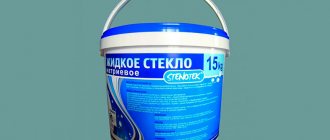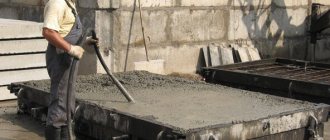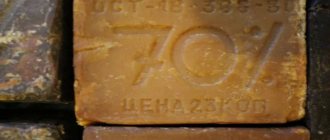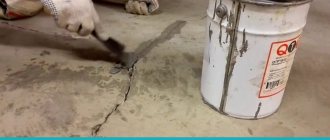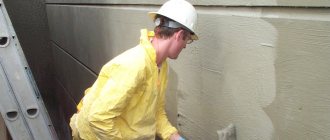Specialists, chemists and technologists are constantly developing more advanced, specialized additives for concrete. But some people believe that all this is a whim and only the naive will pay for plasticizers. And indeed, why, if on the Internet there are a lot of “folk recipes” on how to cheaply prepare durable, elastic and literally indestructible concrete.
Household chemists have been experimenting for a long time with shampoos, soaps and everything that is at hand and have come to the conclusion that no plasticizers are needed when detergents are available. It is they, in their opinion, who are able to provide the concrete mixture with all the necessary characteristics. Therefore, many discarded the idea of plasticizers and happily began pouring detergents into the formwork for 30-50 rubles. But is it worth doing this or does the stingy person pay twice? Let's figure it out with visual tests.
Adding detergents to the cement mixture
The main purpose of adding detergent or liquid soap to concrete is to increase the plasticity and quality of adhesion of the ingredients to each other. They successfully replace expensive plasticizers, significantly improving elasticity and ability to penetrate small voids. It is introduced with the obligatory observance of proportions - no more than 5% of the total mass of the binder, the exact value depends on the type of solution used. This type of impurity requires thorough mixing; the desired effect is achieved only with an even distribution of the compositions between the components of plaster, concrete, masonry or leveling mixtures.
The feasibility of adding liquid soap to mortars
All detergents contain fatty acids and have the same alkaline environment as cement. They dissolve in water without residue and penetrate well into the structure. The advantages of their addition include achieving noticeable plasticity with a minimum W/C ratio, improving adhesion both between particles and fractions, and with the working surface and reinforcement. When these compounds are introduced into concrete, a decrease in voids is observed and the process of pouring and compaction is simplified. Soap in liquid form can be safely used when working with plaster and masonry mortars; in addition to improving crack resistance, the cement mixture does not delaminate and remains mobile in the container longer.
This additive is considered difficult to replace when:
- Preparation of concrete for densely reinforced structures.
- The same for expanded clay concrete, compositions with large fractions, heavy concrete or similar solutions with a low W/C ratio.
- Independent preparation of plaster or masonry mixtures based on Portland cement for the installation of porous blocks.
Liquid soap is added to cement exclusively in diluted form, ideally at the initial stage of mixing the components. Its introduction is provided in advance; it should not be used as a means to increase the mobility of mixtures that have begun to set. In any case, it is inferior in functionality to factory superplasticizers (the effect is achieved through different processes) and does not have a positive effect on such characteristics as shrinkage, water resistance, and the number of freezing cycles withstand. Strength is improved indirectly by minimizing voids with a more uniform distribution of fillers. Disadvantages of use include impaired hydration of cement: with an excess of plasticizers, the structure of the hardened solution changes, in particular, capillaries that remove moisture from the surface do not form.
Input proportions
Liquid soap is not included in the liver of soluble additives in concrete; its dose in relation to other components is not standardized. The upper limit for any factory plasticizer is 5% of the total mass of cement, but in practice it is added much less - from 0.5 to 1%. For ready-made specialized admixtures, this is explained by both the high cost and high efficiency, as well as the risk of efflorescence on the surface, for soap - by the same reasons, plus the lack of control over the timing of hardening and the deterioration of water and frost resistance due to disruption of the hydration processes of the binder. The more complex the composition of the detergent, the less suitable it is for inclusion in construction cement mortars; preference is given to simple, cheap brands.
Recommended proportions depend on the type and volume of mixtures prepared:
- 1 teaspoon (5-10 ml) per 10 kg of Portland cement. This ratio is universal; it can be used when pouring soap into plaster and masonry compositions, and preparing leveling compounds for screeds. It is indicated for formulations in liquid form.
- 50-100 g (ml) per 1 container of a medium-volume concrete mixer when preparing cement-based solutions with the addition of coarse filler: crushed stone or gravel for pouring monolithic structures, including foundations. The W/C ratio is minimal - about 0.5-0.65.
- 50-100 g of liquid soap per 1 bucket of Portland cement with strength grade M400 and 4 buckets of sand when mixing masonry mortar.
- 1-2 tablespoons per 25 kg of cement when preparing expanded clay concrete. The larger the expanded clay fraction, the higher the effect of using the plasticizer. Liquid soap in this case, by analogy with ordinary concrete, is mixed with water, but the formation of foam will be unnoticeable, and you should not expect high mobility. Its presence in the composition improves the strength characteristics; the binder quickly envelops the smooth fractions of baked clay and glues them well.
The general rule applies: the proportions of liquid soap are calculated based on the weight of the cement, regardless of its strength grade. The upper permissible dose when mixing components within standard ratios is always observed. When using M300 or M500 cement, the volume of soap poured with water is the same.
Reducing the dose is pointless - the effect of improving adhesion and plasticity simply will not be achieved, increasing it is undesirable: efflorescence may form due to leaching of salts from the mixture.
In some cases, the introduction of diluted soap is undesirable: these include the preparation of cement mortar based on sand with a high clay content or other impurities. But this drawback can be easily eliminated - just rinse and dry the filler. It is easier to remove formwork from structures filled with such concrete, but their rate of setting and hardening slows down; if the work is limited, it is worth looking for another way to improve adhesion. Sometimes soap is poured into a concrete mixer only at the last batch in order to simplify its washing.
Unlike many additives to concrete and cement mixtures, this one is introduced not at the end, but at the beginning, along with the main dose of water. In this case, the composition is completely distributed between the grains of the binder and fillers and evenly envelops them. Liquid soap is mixed with water, but not shaken; when foam forms, the concrete mixer or construction mixer is stopped and waiting for it to settle. Properly mixed cement mortar should not delaminate or have whitish streaks. It can be used immediately after preparation; at all other stages of work it does not differ from the usual one.
Liquid soap and plasticizer: the fundamental difference in composition
What is the difference between liquid soap and plasticizer? Can it replace plasticizer?
The plasticizer was developed in the laboratory as an additive for concrete and tested before going on sale, so there is accurate, verified information on how to dose it and what properties it imparts to concrete.
Household detergents are developed for completely different purposes, and accordingly, they must have certain characteristics that meet these purposes.
There are a huge number of varieties of surfactants, which are made from raw materials of mineral or plant origin and are divided into four main groups:
- anionic;
- cationic;
- amphoteric;
- nonionic.
As a rule, plasticizers include anionic surfactants. In detergents, anionic surfactants are combined with amphoteric or nonionic ones.
The concentration of surfactants in detergents is indicated approximately, and we will never be able to know exactly how much of any surfactant is in liquid soap or shampoo. Any statements by experienced builders that detergent X should be added in, say, 50 g per bag of cement, do not apply to product Y, since the compositions of detergents differ greatly from each other.
Detergents contain a large number of auxiliary components; Even dishwashing detergents now contain glycerin, emollients and other ingredients that are not needed in concrete. How they will affect concrete is not known, since no one has conducted such tests.
But the main problem with liquid soap is the chloride salts in the composition.
Sodium chloride is used in detergents as a cheap thickener for anionic surfactants. But it is not useful for concrete, since it promotes corrosion of reinforcement and the appearance of efflorescence on the surface of concrete.
Why you shouldn't use liquid soap instead of plasticizer for concrete
Specialists, chemists and technologists are constantly developing more advanced, specialized additives for concrete. But some people believe that all this is a whim and only the naive will pay for plasticizers. And indeed, why, if on the Internet there are a lot of “folk recipes” on how to cheaply prepare durable, elastic and literally indestructible concrete.
Household chemists have been experimenting for a long time with shampoos, soaps and everything that is at hand and have come to the conclusion that no plasticizers are needed when detergents are available. It is they, in their opinion, who are able to provide the concrete mixture with all the necessary characteristics. Therefore, many discarded the idea of plasticizers and happily began pouring detergents into the formwork for 30-50 rubles. But is it worth doing this or does the stingy person pay twice? Let's figure it out with visual tests.
Summing up
Yes, someone may say that the tests were carried out in an incomprehensible laboratory and perhaps it was the plasticizer manufacturers themselves. But numbers are stubborn things. And the arguments of those who used advice about “soap” are even more stubborn. Someone claims that the strength of concrete decreases due to the soap solution, but only by 5%, which theoretically is not so critical. But there are also many who rejoiced at how elastic the mixture became and did not dry out for a long time, and after 28 days they realized that the concrete could be crushed by hand.
Therefore, it may be better to purchase a specialized product from a trusted manufacturer (there are many of them on the market) than to take risks. But, of course, it's up to you to decide.
Advantages and disadvantages of the supplement
Plasticizing additives are dry and liquid. The advantage of liquid additives is ease of dosing and mixing. They easily dissolve in water, which is used when mixing concrete; You can also add them directly during mixing.
Advantages of liquid plasticizers:
- Increases the plasticity and fluidity of the mixture.
- They improve workability and reduce the cost of vibrating concrete.
- Mixtures with a plasticizer, due to their mobility, fill even densely reinforced formwork well without forming voids.
- They contribute to the compaction of the concrete mixture, and the concrete is dense and durable.
- Increases the water resistance and frost resistance of finished structures.
- Reduces cement and water consumption. This means that with a plasticizer it is possible to obtain a concrete class higher than that declared, so you can use cement of a lower grade or reduce its amount by 10-15% without loss of strength. (For example, when using the additive for heated floors CEMMIX CemThermo, the declared strength of concrete is achieved already at the age of 10 days).
- Improves adhesion to reinforcement.
- They improve the mixing of cement mortar components, prevent the mixture from separating and settling of aggregates.
- Increase the time of working with the solution. Concrete mortar without additives begins to set within 3–4 hours, which is inconvenient if it needs to be transported. Adding a plasticizer solves this problem.
- Special plasticizers for heated floors compact the screed and increase heat transfer.
Disadvantages of plasticizers:
- Plasticizers in powder form must be dissolved in water in advance.
- A large amount of plasticizers causes the concrete to take too long to set.
- Plasticizers need to be purchased. But by spending money on the purchase of these additives, we simultaneously save money on cement, water, and electricity required for processing concrete.
Why is binder needed?
The binder components react with water and, as a result of chemical processes, a new substance is formed. Cement and water or lime and water separately and after reaction are completely different substances, so you cannot think that the solution simply dries out; it crystallizes, gains strength, and the final strength of the coating depends on how correctly the proportions of the binder component and water were maintained.
Sand
There are no trifles in the matter of plastering.
Plaster primarily levels surfaces, so the use of coarse or mixed-grade filler is unacceptable. Washed quarry or fine quartz sand is used in plaster mortars and must be sifted through a sieve with a mesh size of 1.5 mm, since even a small amount of small pebbles can spoil a perfectly smooth and even plastered surface.
Study of a concrete mixture made from plastic waste with a plasticizer
The fresh and hardened properties of virgin plastic mix concrete were studied (CUR Report 1991). A series of concrete mixtures were prepared in which sand was partially replaced by plastic waste in varying percentages by volume. Concrete waste plastic mixture with and without superplasticizer was tested at room temperature. Forty-eight cubic specimens were cast for compressive strength tests after three, seven and twenty-eight days. Eight beams were also cast to study the flexural strength characteristics of plastic waste concrete. It was found that the reduction in workability and compressive strength due to partial replacement of sand with waste plastics was minimal and could be enhanced by the addition of a superplasticizer.
Why do you need a plasticizer for plaster mortar?
To prepare cement mortar, water and cement are mixed in certain proportions, which are called water-cement ratio. The ideal water-cement ratio is 0.45–0.55. But the mixture turns out to be very thick, heavy, and inflexible. It is difficult to lay, and it sets quite quickly, making further work difficult.
Adding more water seems like the logical thing to do. The mixture will immediately become more pliable, but the price of this convenience is reduced strength of the hardened coating.
A plasticizer helps to get out of this situation beautifully.
Minuses
If you decide to use liquid soap as a supplement, there are a few things to keep in mind.
- Liquid soap always leads to a decrease in strength. It is extremely difficult to control the air entrainment process on a construction site, which is why it is always high.
- The required dosage is unknown. Most likely, almost any amount of liquid soap will produce excessive air entrainment or will not have an effect in changing the properties of the mixture.
- Due to the penetration of water through capillary suction into the structure and freezing in the off-season, the water will expand and tear it from the inside.
Properties of PVA glue
The substance acts as a plasticizer additive. As a result, cement with PVA acquires new properties.
- increasing the plasticity of the solution: thanks to this, concrete can withstand tensile and compression loads, thereby reducing the risk of cracks in the finished cement structure;
- adding PVA increases the service life of the finished structure;
- adhesion of materials increases, while the strength of concrete increases;
- if PVA is added to the cement mortar, working with the finished material is much easier;
- thanks to the adhesive composition, the screed is better held on a horizontal surface;
- the surface does not deform under intense loads;
- the composition acquires a more uniform consistency, while much less effort is expended compared to the process of preparing a standard solution;
- the wear resistance of the material increases.
When using PVA glue, you can make a tile adhesive from a standard solution. Thanks to a set of positive qualities, the scope of application of the substance is expanding. The mixture will adhere well to different surfaces: concrete, brick, etc.
What is liquid soap used for in solution?
Builders do not really like to work with classic concrete mortar due to its low mobility. It spreads poorly and fills cavities and voids in structures poorly.
To increase plasticity in a simple way, two methods have been found:
- adding more water to make the solution flow better;
- adding detergent.
The first method quickly proved its failure, since water in excess of the established norm reduces the strength and durability of concrete. Excess water in the solution is generally considered a concrete killer.
Liquid soap and washing powders added to concrete give it good plasticity. This method has caught on, but has divided builders into two camps: some are for, others are against, soap-based concrete. Where is the truth?
Technical salt
A very interesting option that is recommended to be considered in detail. Technical salt increases the frost resistance of the solution, being a kind of plasticizer. Its addition in a reasonable amount does not impair the consumer qualities of concrete. According to professionals, 2% of the total mass will be enough to make the concrete resistant to frost and quickly harden at sub-zero temperatures.
People also actively use ordinary salt. It increases the heat resistance of the solution, so it is added when laying stoves, hearths, etc. Please note that an excessive amount of salt in the concrete solution can lead to an acceleration of corrosion processes, which is unacceptable in the case of the manufacture of reinforced structures.
Why add liquid soap to cement mortar and concrete?
Why add liquid soap to cement mortar?
The content of the article
In some cases, for example, when you need to ensure that the cement mortar does not shrink when plastering walls, you can do without a purchased product. Many builders use ordinary liquid soap, shampoo and powder to increase the mobility of the plaster mixture. How to make a plasticizer with your own hands for concrete or cement mortar will be discussed in this review of a construction magazine
Why add liquid soap to cement mortar and concrete?
Liquid soap is added to the cement mortar at the stage of preparing the mixture. Its addition allows you to increase the fluidity of the solution, make it more plastic and convenient to use. In most cases, this property of Portland cement-based mortars depends on the quality and type of sand.
Surely many people have encountered when plastering walls that the mortar “shrinks”. So, if you add liquid soap to such a solution, you can avoid this problem and thereby increase the quality, efficiency and speed of plastering work.
In addition to liquid soap, it is added to cement mortar and powder with shampoo. The effect of adding them to the building mixture is approximately the same. All these means make it possible to increase the fluidity and plasticity of solutions without compromising their strength.
By the way, if you dilute the solution with water after some time of preparation, it will become less durable, which will certainly affect the quality of finishing work.
If there is any doubt about the use of liquid soap and other detergent in the solution, then you can use slaked lime. The effect of adding slaked lime to a cement mortar will be approximately the same, plus lime acts on the concrete mixture as a good bactericidal agent. How exactly to add lime to cement mortar will be discussed below.
Proportions of liquid soap in relation to cement
Liquid soap, as a plasticizer, is added to the water at the stage of preparing the cement mortar. In this case, the amount of liquid soap should not exceed 5% of the total mass of the building mixture. Or so, 200 ml of shampoo or liquid soap is used per 50 kg of cement when mixing concrete or cement-based solutions for plastering walls.
As mentioned earlier, not only liquid soap, but also powder can be used as a plasticizer for concrete. The proportions of powder to cement when mixing the solution are as follows: 150 gr. powder per 50 kg of cement. Any detergent can increase the fluidity of the building mixture, improve its elasticity and adhesion to reinforcing elements.
In addition to all of the above products, ordinary slaked lime is also used as a plasticizer for concrete. In addition to improving the mobility characteristics of solutions, lime acts on them as an effective bactericidal agent, preventing the spread of fungus and bacteria.
To use slaked lime, it must be added to the cement mortar with water in an amount of 20% of the total mass of the building mixture. To increase frost resistance and other properties of cement mortars, you should use other types of plasticizers, which are presented today in a wide range of construction markets.
Proportions used
In private practice, it is customary to add 50–100 g of soap per 1 portion of concrete in a concrete mixer (or 1 teaspoon per bucket of cement). Reducing the proportions simply does not lead to the desired effect, and increasing them promotes the removal of salts from the solution and the formation of efflorescence after hardening. If there is an excess of foam, the processes of cement hydration are disrupted, which is unacceptable, especially when concreting at low temperatures.
The selected proportions do not depend on the brand of concrete and the Portland cement included in the composition; they must be within 5% of the total mass. But they affect the W/C ratio; it is better to mix the solution gradually, adding the last 10–15% of water in small portions.
The optimal amount is 5–10 ml per 10 kg of Portland cement. Soap is introduced in liquid form into a concrete mixer before adding fine and coarse filler. An important nuance: in this case, cement mortars are significantly influenced by the characteristics of sand. When purchasing it with clay impurities, you should not add detergent or soap; small suspensions only worsen the quality of the compounds. It is not recommended to use cleaning powders or grated laundry soap; in addition to poor dissolution, they contribute to the removal of salts from concrete.
As an example, consider a recipe for preparing cement masonry mortar with the addition of detergents. In this case, to create a mixture with the M100 brand, a ratio of 1:4 is better. For 1 bucket of M400 binder, take 4 sand and 50-100 g of liquid soap. As the cement strength grade increases, its proportions decrease. That is, for masonry mortar M100 from Portland cement M500, a ratio of 1:5 is used. It is noteworthy that the consumption of detergent does not increase, it is still the same 50–100 g. The most difficult thing is to calculate the required amount of water, but it is strictly forbidden to increase its proportion in the solution.
There is no point in using expensive liquid soap from well-known manufacturers. On the contrary, the simpler the composition, the lower the risk of the presence of substances in it that are incompatible with Portland cement or affect it in an unexpected way. All that is required from this additive is foam and rapid dissolution in water. It is worth considering that introducing it into a ready-made solution does not give any noticeable effect (unlike many other modifying components, which, according to the rules, are poured into a concrete mixer in the last minutes of rotation). That is why liquid soap is added at the beginning of the kneading, enveloping and connecting all particles and fractions.
The solution preparation time is increased by 3–5 minutes until the substance is completely dissolved in water. But it is compensated by the acceleration of the mixing process for concrete with expanded clay.
Some experts advise, when using soap compositions, to fill in the dry filler in parts: first half of it, then all the cement, and then the rest of the sand. The finished solution has a thick consistency; no water should be released. And what is important, you should wait until the foam is distributed and dissolved; you cannot work with foamed compounds. That is, the same principle applies: the more homogeneous the concrete, the better it is.
Soap or plasticizer: what to choose for cement?
Liquid detergents actually give the cement mortar greater plasticity and prevent its delamination. However, in this case, a large amount of air is drawn into the mixture, which leads to less dense concrete and reduced strength. Therefore, builders who value their reputation as craftsmen choose a plasticizer. Its advantages include:
- a composition developed for specific tasks - to impart certain properties to concrete;
- thorough testing during laboratory and production tests;
- precise information on dosage and specific use.
Unlike plasticizer, liquid soap was created for completely different tasks. Therefore, its addition to concrete can have unpredictable results. And not always exactly what the builders were counting on.
Why add detergent to concrete for heavily reinforced structures?
If you do not exceed the permissible amount of liquid soap, resistance to cracks is observed, and the finished mixture does not separate into its component parts for a long time. In this way, the construction period can be extended, and cement or concrete can be mixed in large doses, which can significantly save time and effort. Liquid soap is considered an additive that is difficult to replace with anything when preparing such solutions.
Why add detergent to concrete:
- Concretes for densely reinforced structures require better penetration characteristics
- For the preparation of expanded clay concrete. The composition contains a lot of large fractions and heavy concrete, which impairs the miscibility of the component parts with each other. In order for the mixture to be convenient to work with, it is necessary to add a large amount of water, which is undesirable due to the increase in hardening time.
- When preparing plaster and masonry mixtures using Portland cement. This is an indispensable additive during the installation of porous blocks, which require high fluidity of materials that flow into almost all cells of the block.
Plasticizer


